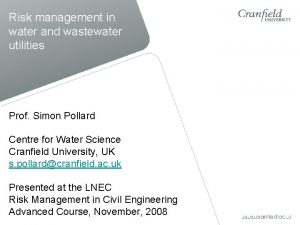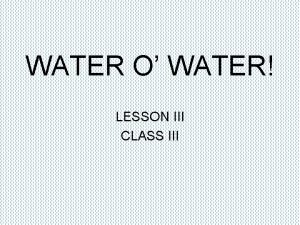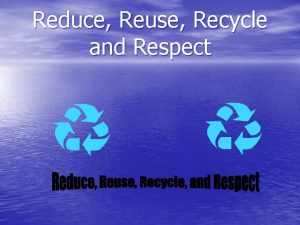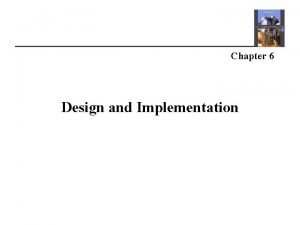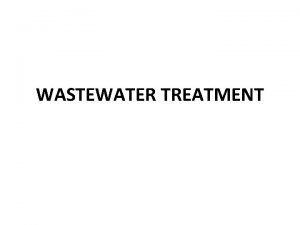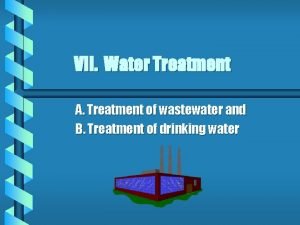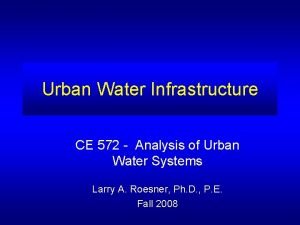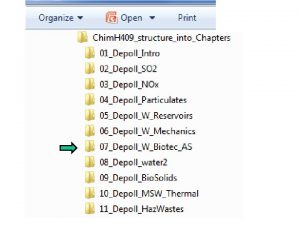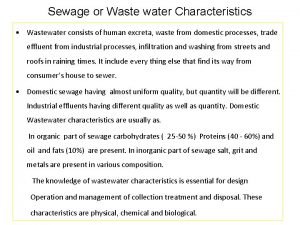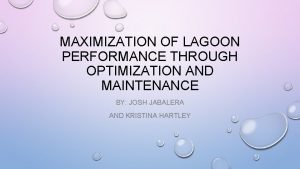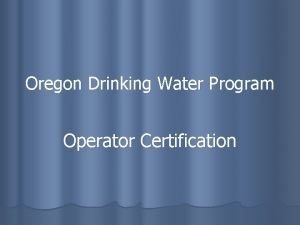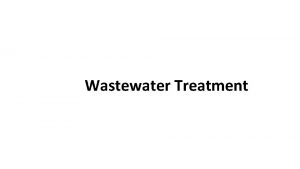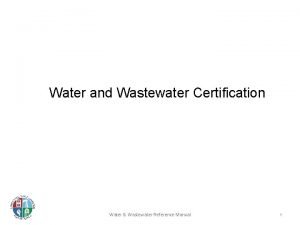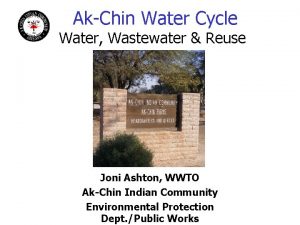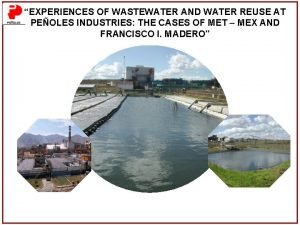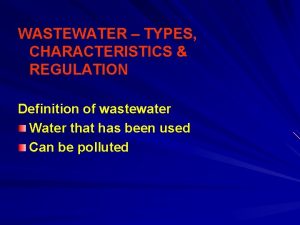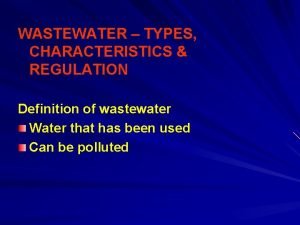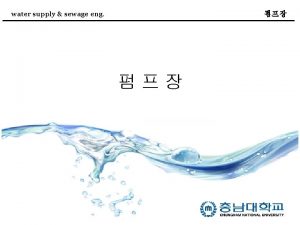Wastewater and Water ReUse in Israel Eng Alexander















- Slides: 15

Wastewater and Water Re-Use in Israel Eng. Alexander Kushnir Director General Israel Water & Sewage Authority March 2012 1

Overview • Israel’s Water Challenges • Nation-Wide Domestic Wastewater Treatment and Re-Use in Agriculture • Next steps • Conclusions 2

Challenge: Minimizing the gap between supply and demand • Israel is located in an arid region of the world. • Continuous nation-wide efforts and innovations have played a vital role in minimizing overconsumption. • By responding to the unavoidable challenges of water scarcity, Israel has become one of the world leaders in water conservation 3

Challenge: Providing Consistent, Sustainable National Water Supplies Key Historical Innovations: 1960’s – Construction of the National Water Grid: transports water from the Sea of Galilee southwards, irrigating the Negev desert. 1980’s – Droughts and increasing water demands – Initiated re-use of domestic effluent for irrigation 2000 – Droughts and further increases in water demands – Initiated large scale seawater desalination Throughout the Past, Present, Future: Improvements in water use-efficiency in all sectors. This includes new methods of reducing water demands and water losses. 4

Towards a sustainable balance Added Supplies: • Large-scale re-use of treated wastewater in agriculture and other sectors is the biggest step towards sustainable water-use. • Decreasing future desalination requirements Allocations for Nature: • Preserve natural water resources • Preserve water for the environment 5

Challenge: Managing the Quality and Nation-Wide Distribution of Israel’s Many Unique Water Supplies • Sea of Galilee and Watershed • Fresh water aquifers • Brackish water aquifers • Storm water • Effluent (treated domestic wastewater) • Desalinated water • Greywater - Future increases in the safest, most economical way. Each of these originates in different locations, has different quality-levels, & has different energy-requirements for supply 6

Challenge: Water Shortages in Agriculture Innovations: • Irrigation with domestic effluent • By 2016: Increase the proportion of tertiary or tertiaryplus level effluent to 90%, to enable its unlimited irrigation. • Advanced irrigation systems (eg. drips released immediately beside the roots) • Maximize use of storm water • Crop tolerance of: brackish water, minimal water The most cost-effective water-energy balance is obtained by using these methods of reducing demand re-using 7 resources.

90 80 Effluent Quantity for Irrigation: Percent of National Effluent Used 80 70 60 % 50 40 30 17 20 10 0 Is rae l Sp ain 10 A us tra 8 5 Ita G lia ly 1 ree ce Ce 1 ntr US A al Eu ro Next Steps (Improvements Within 5 -7 Years): Israel will increase use of the total national effluent produced each year from 80% to 90%8 pe

Effluent-Quality for Irrigation Currently: Ø Monitor and ensure all quality parameters to prevent any potential long-term harm. Ø Reduce salts by combining desalinated water with natural potable water. Results: higher effluent quality higher plant yield & lower water requirements Next Steps (Improvements Within 5 -7 Years): Ø Raise effluent quality from secondary to tertiary to increase tertiary-level effluent from 36% to 90%. 9

National Consumption: Agricultural Sector 2050 2010 500 (48%) 400 (38%) 144 (14%) 350 (26%) 900 (67%) 100 (7%) If effluent were not used in agriculture, desalinated water production would be required (a more costly alternative) to supply the agricultural sector’s needs.

Increasing Proportion of Effluent in Agricultural Consumption Currently, effluent provides ~38% of the water used for agriculture in Israel …. and plans are to increase this to 67% by the year 2050 11

Next Steps: Improvements in Wastewater Purification & Re-Use in the Next 5 -7 Years Quantity – Increasing the total percentage of reused effluent from 80% to 90% Quality - Upgrading tertiary-quality effluent from 36% to 90% 12

Options in Effluent Management Effluent Re-Use Systems – National, Regional, Local Tariffs – True cost, Government subsidy, Cross-Sector Financing Maintenance – Government, Private, Both 13

Conclusions • Water shortages have led to national-level innovations in water conservation, re-use, and desalinated supplies. These have made Israel one of the world’s leaders in water use. • The Israeli model can provide assistance to the global community; not only to arid countries. • The most cost-effective methods have been used to reduce water demands and re-use resources. • Nation-wide use of effluent provides almost 40% of the agricultural sector’s water. • During the coming 5 -7 years, effluent that is used in the agricultural sector will increase in both quantity (use of 90% of all effluent ) and quality (90% treated at tertiary-level) 14

Thank you ! Don’t Waste Your Waste! 15
 Water and water and water water
Water and water and water water Shartli ekstremum
Shartli ekstremum Risk management for water and wastewater utilities
Risk management for water and wastewater utilities How can we reuse water for class 3
How can we reuse water for class 3 Reduce reuse recycle respect
Reduce reuse recycle respect Advantages and disadvantages of dialyzer reuse
Advantages and disadvantages of dialyzer reuse In design and implementation, reuse levels are:
In design and implementation, reuse levels are: Wastewater treatment purpose
Wastewater treatment purpose Aquaculture water treatment
Aquaculture water treatment Wastewater treatment process primary secondary tertiary
Wastewater treatment process primary secondary tertiary Wastewater distribution system
Wastewater distribution system Typical composition of untreated domestic wastewater
Typical composition of untreated domestic wastewater Physical characteristics of wastewater
Physical characteristics of wastewater Optimize wastewater lagoon
Optimize wastewater lagoon Ashbridges bay wastewater treatment plant
Ashbridges bay wastewater treatment plant Oregon water treatment certification
Oregon water treatment certification


